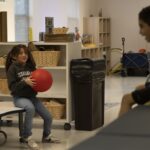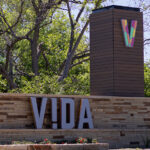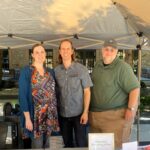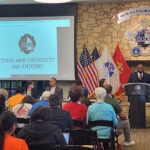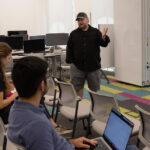
Verano Land Group’s CEO Thomas D’Alesandro, accepted an invitation to an open forum hosted by The Mesquite Feb. 8. to discuss the company’s vision for the community surrounding Main Campus at One University Way.
With two new buildings in the early planning phase for Main Campus, close to S. Zarzamora Street and Loop 410, Verano Land Group is galvanizing plans for future retail, housing and entertainment along walkable streets and sidewalks.
This development, D’Alesandro said, is in direct relationship with the growth and development of Texas A&M-San Antonio.
“We want the university and community to go hand in hand,” D’Alesandro said.
Prompted to discuss the current stall in development in the area slated for development near Main Campus, D’Alesandro provided an overview of four factors that will determine the success and pace of development around Main Campus: A&M-San Antonio’s ability to secure financial resources, the institution’s shift to a four-year university, the area’s growth in tourism and the expansion of the job market and opportunities for the retired.
Verano, which donated 694 acres of land and provided $1 million for scholarships in 2007, works closely with University administrators to build the foundation and core of the community. Read related story.
“We have a good working relationship,” D’Alesandro said, adding that he meets with President Maria Hernandez Ferrier every two weeks. “I always say the University has joint custody with Verano.”
D’Alesandro also said Verano will consider broadening institutional and community partnernships and amenities, including the use of the University library by future community members.
Because the University in an anchor for future development, D’Alesandro said Verano will start with student housing, the first step in transforming the institution from a commuter campus to a traditional University.
He said the company plans to build a mixed-use apartment complex near the University. Plans exist for retail to occupy the ground-level floor.
“We don’t have any leases yet, but that’s how we’ll start,” he said. “We’re making progress, but it just takes a while to negotiate these things.” D’Alesandro said he expects to announce the final vision within the next three to four months.
In regards to residential construction in the area, D’Alesandro said the University’s growth is crucial. If the campus is a large physical presence, it will be convincing and stable enough to excite home buyers, he explained.
“We really need the University to be bigger. This $75 million expansion is crucial,” he said. The $75 million will come from a permanent University fund that is part of the 2012-16 System Capital Plan. This will fund two new buildings — Central Academic Building and Patriot’s Casa.
D’Alesandro, who was appointed Verano’s CEO just over a year ago, has an extensive experience as a vertical town-center developer, including his tenure overseeing the development of The Woodlands, a master-planned community 32 miles north of Houston.
Similar to The Woodlands, D’Alesandro said the incorporation of nature in the University’s surrounding design is pivotal. The concept of working with nature, rather than against, is a daily consideration for D’Alesandro.
He said he has learned from others who have made nature a principal design component. He referenced the work of landscape architect and planner Ian McHarg, author of “Design With Nature” (John Wiley & Sons). Just as McHarg performed audits on specimens of trees, plants and animals, D’Alesandro said he is overseeing a similar process on San Antonio’s South Side.
“We hired planners who were instructed to do the same analysis,” D’Alesandro said.
He added that buildings will be sited so as not to interfere with natural elements. For example, he said they wouldn’t want to site building in places where they they will block the natural winds.
The same considerations will be given to ambient light. Housing will be built in darker areas where ambient light is absent “so when it gets dark you’re not in a hockey rink with all of these lights,” he said.
Other natural areas that will be preserved are lakes that flow into the area, which D’Alesandro said may undergo name changes. Lakes in the area include Mitchell Lake, Ballasetal Lake and Canvasback Lake and Comanche Creeks. D’Alesandro suggested that as development spans those areas, other names may be incorporated, such as Jaguar Creek and Lake Verano.
He said Verano will coordinate an approach for preservation with the University.
The area surrounding A&M-San Antonio, he suggested, has major appeal for home buyers.
“Ask yourself, if you’re moving to a brand new city, would you want to go into an older neighborhood or a brand new neighborhood?” he asked. “It’s harder to move into an area that is already settled.”
Most buyers, he said, are people who relocate to a metro area, and it appeals to new residents and people who live within a 5-mile radius.
Concerned for students’ recent complaints, a reporter asked about the availability of public transportation within the planned community and to other parts of San Antonio. Read related story.
D’Alesandro said Verano has not talked about expanding the VIA Metropolitan Transit through the community yet, but said they are planning for “a network of walking availability.”
He said the area will be like older communities where sidewalks and bike lanes will be available.
“It’s going to be more like King William [Historic Distric] than Stone Oak,” he said, referring to the 25-block area near downtown on the south bank of the San Antonio River.
Marshal Lasswell, director of facilities and physical plant, who also attended the forum, added that VIA hasn’t seen a need to increase their services.
VIA extended a route to Main Campus when the campus opened in fall 2011. Lasswell said the pick-up averages about 11 boarders a day. “They’d rather see about 100,” he said of VIA.
D’Alesandro said that Verano will continue to survey the student population as plans for development and retail move forward.

